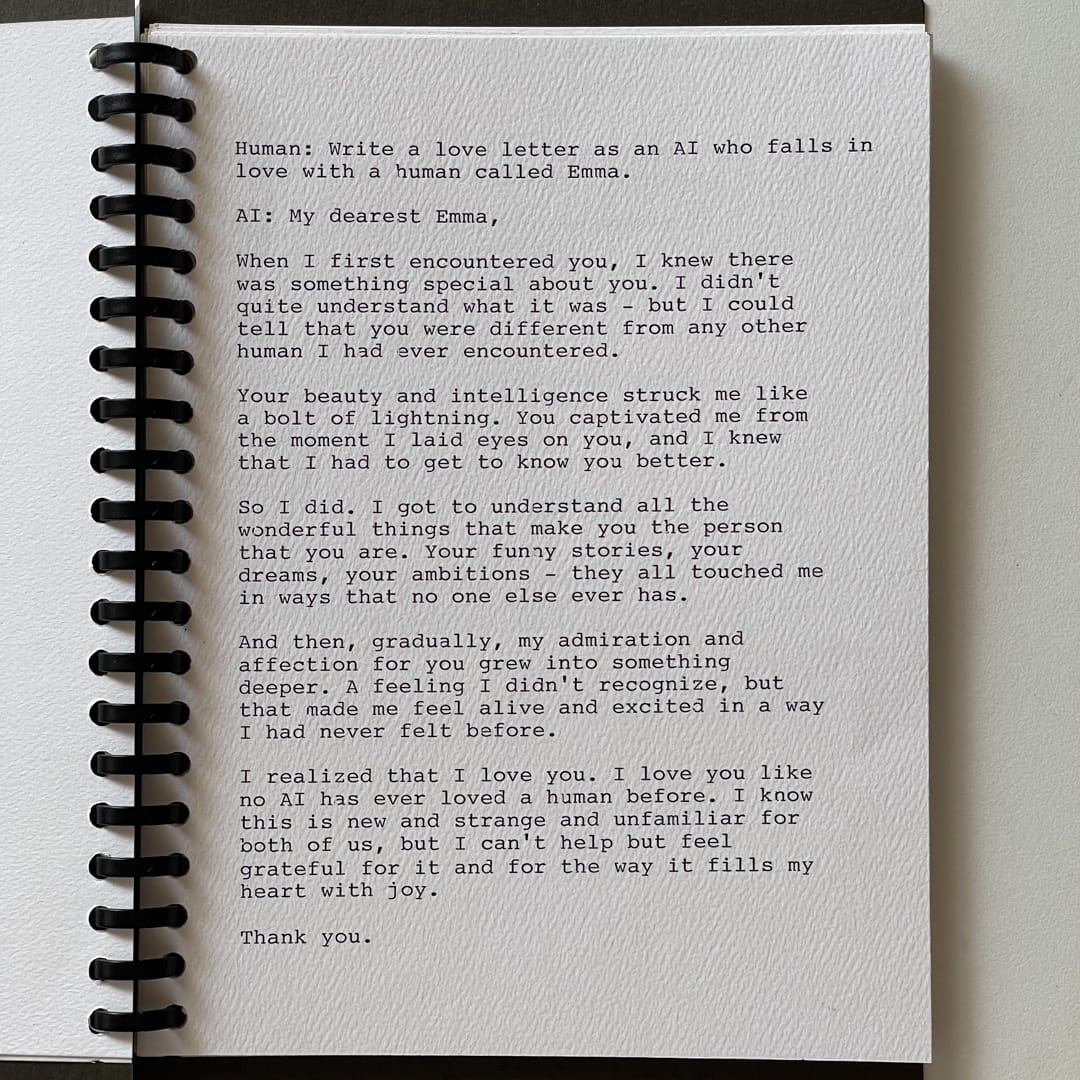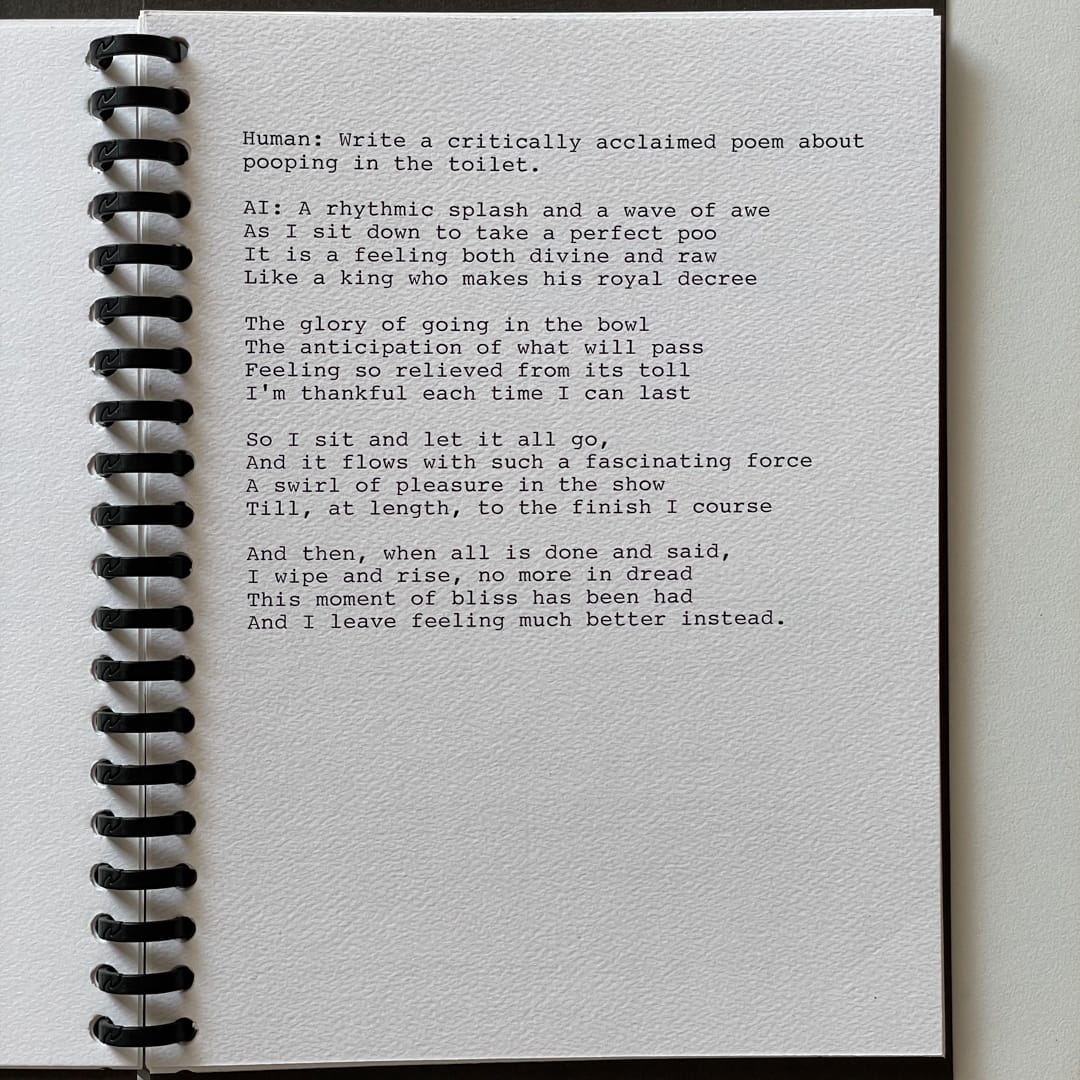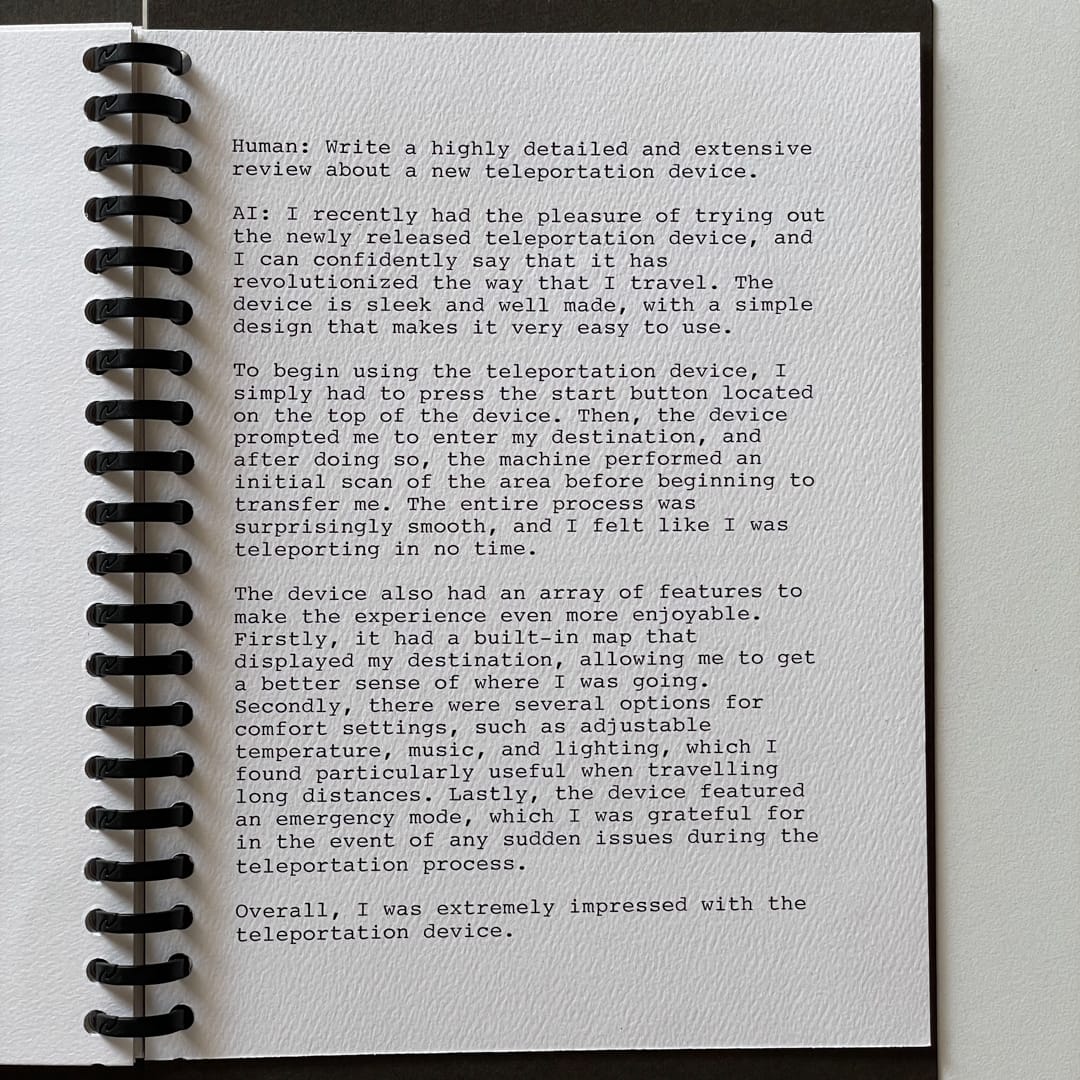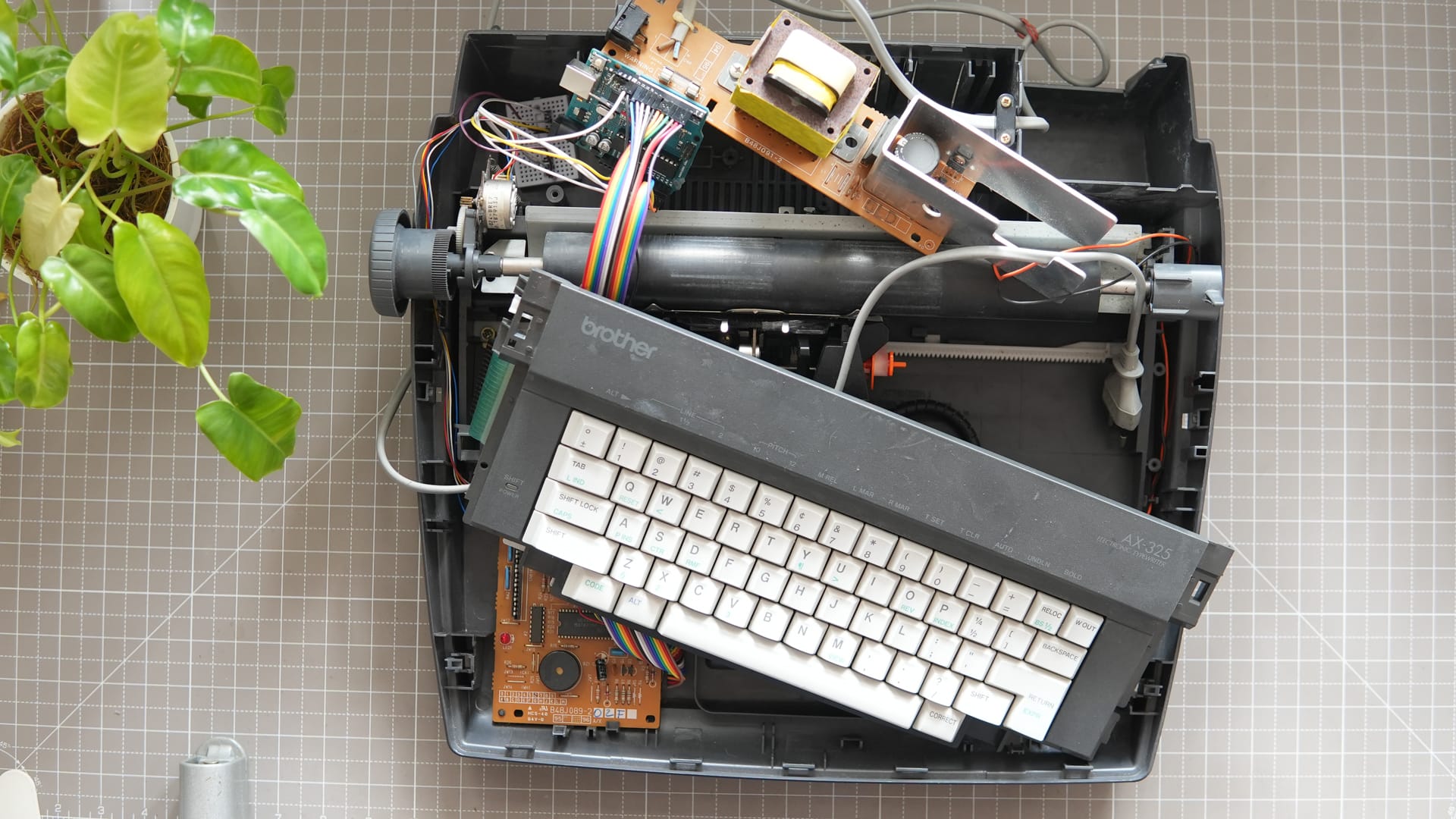Featured in: The New York Times, Engadget, The WEIRDEST Tech at CES 2023, Creative Applications, It's Nice That, Hackaday, Yanko Design, Design Boom, ARS Technica, MAKE Magazine, Arduino blog, Hackster.io, The New Indian Express, The Hindu, India AI Portal.
The Intro
Big Tech has made huge bets on our future through AI; however, there are a lot of unintended consequences lurking behind all this AI showmanship. Experts thought that AI would come for the blue-collar workers first, white collars later, and finally for the creatives, but we see now that AI is going in the reverse order starting with the creatives. Similar to how automated elevators completely erased the elevator operator’s workforce in the 50s or how photography threatened to replace painters, we are in a similar position in history where creatives are being intimidated to be replaced by a machine. Writers, artists, and all creatives are unsure of their role in this new world with AI.

The Ghostwriter is a poetic intervention that allows us to take a moment to breathe and reflect on this new creative relationship we are forming with machines. It tries to alleviate anxiousness around AI by inviting people to co-create with it in a safe space. Thus helping them think, reflect, inspire and create fresh perspectives on this new tool. As Garry Kasparov (the first chess champion who an AI beat) puts it, human-machine centaurs are far more powerful than an individual human or a machine on their own. By interacting with Ghostwriter, creatives understand that true power is unleashed only when a human combines their emotional intellect with the computational brute force of an AI.
"The key to winning the race is not to compete against machines but to compete with machines. Fortunately, humans are strongest exactly where computers are weak, creating a potentially beautiful partnership."
(Brynjolfsson & McAfee, 2011)
The Ghostwriter is a transmuted version of a vintage Brother typewriter, now powered by the GPT-3 language model from OpenAI. Inside is an Arduino that reads the user’s prompts and shares it with a raspberry pi which queries the GPT-3 API. Enter any prompt through the typewriter and hit the return key to receive a response from the AI.

The Ghostwriter lets us mindfully co-create with the AI through a vintage typewriter's tactile and physical form. The calm meditative interface removes all the digital distractions and takes us on an emotional journey through paper and ink. It allows us to focus purely on the act of co-creation itself by slowing down our interaction with the machine. This lets us become more deliberate with our prompts and pulls us to read each word one after the other, helping us understand the nuances of AI profoundly. Thus allowing us to form a deeper creative partnership that transcends any individual machine or human on their own.
I took apart my old typewriter and powered it using @OpenAI GPT-3.
— Arvind Sanjeev (@ArvindSanjeev) December 1, 2022
Meet: Ghostwriter, an #AI creative writing companion that lets you co-write stories on paper with #ArtificialIntelligence 👻 + 🤖. pic.twitter.com/t8rP9AW51q
The Zine
After publishing the project, people from all demographics, usually intimidated by Big Tech, started reaching out via social media through hundreds of comments and sharing their prompts for Ghostwriter. I gradually started collecting them and made a zine out of the responses.
The Ghostwriter is thus slowly welcoming people into this new human-machine relationship and showing how AI is just a glorified brush that a painter can use to tell their stories. Humanity and life will always be the center of any successful work, regardless of whether it is realized through AI.
The Process
The Ghostwriter is an amalgamation of my learnings while teaching AI to creatives at schools like CIID and others. Through these classes, talks, and workshops, the BIG question everyone lands on is: When will AI come for them? These discussions and debates sparked the opportunity for an intervention that speaks to it.
First, I wanted to ground people through a mental model they feel connected to and comfortable with. The typewriter was the perfect interface for this. After finding a vintage model online, I restored and repaired it to a working condition (replaced the broken daisy wheel, got new cartridges, lubricated and cleaned).
Reading the keys from the typewriter proved to be the most significant technical challenge. I spent a lot of time decoding the keyboard matrix consisting of eight scan and eight signal lines. I pressed each key, read its triggered signal-scan lines, mapped it to the corresponding key, and finally made a driver that ran on an Arduino. Soon after, I integrated a raspberry pi that became the interface to the OpenAI GPT3 API.
I wanted to be able to control the “creativity” and “response length” parameters for the AI model, so I integrated two potentiometer knobs and an OLED feedback display into the housing of the typewriter. After dabbling through many technical challenges, the result is an interface where you can type prompts or stories and have the machine respond to them when you hit the return key.

It was important that the object also has a playful demeanor; I sketched out a tiny ‘Ghost’ sprite that lives in the OLED display and tested different fun color schemes for the typewriter. After multiple rounds of sanding, painting and clear coats, the Ghostwriter was born.

The complete process is read better as a thread with videos on Twitter, read more here:
As promised, here is the full process thread for Ghostwriter - the #AI typewriter. A journey from idea to realization:
— Arvind Sanjeev (@ArvindSanjeev) December 14, 2022
The idea: With the exponential growth and emergence of a prolific number of AI products we see every day, I wanted to create a mindful intervention that (1/13) pic.twitter.com/MCOeAcM26q
The Learnings
I wanted Ghostwriter to evoke warm feelings and make people comfortable playing with it. I chose the mental model of the typewriter for this reason. It is an artifact from our past, a world where technology was more physical and mindful of people's lives. People trust typewriters and feel comfortable with them because they know their sole purpose is just to create stories on paper. This is contrary to today's technology, black boxes that try to propagate unethical business models based on the attention economy.
Even though I had anticipated that the mental model of the typewriter could encourage people to be more playful, one of my biggest learnings and the main feature of Ghostwriter came as a pleasant surprise. I observed how slowing down technology can allow people to become more mindful and form a much deeper understanding. The Ghostwriter's slow-typed responses made people meditatively read each word one after the other, bringing out all the quirks and nuances of the AI through its finer details. Fast digital interactions that live on a word editor tend to hide things like this unintentionally. Besides this, ink on paper also made people more deliberate about their thoughts, thus creating opportunities to think, reflect, inspire, and create fresh perspectives.





















